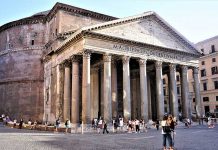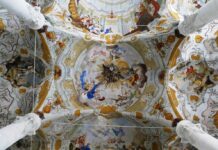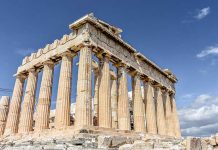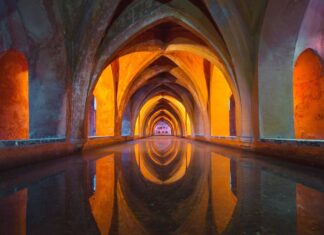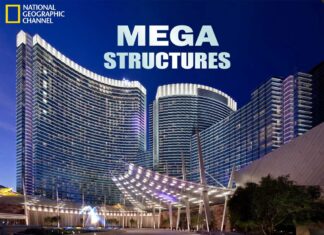The Roman Empire, which established one of the greatest civilizations in history, left its mark on history in terms of art, culture, economy and social society. Thanks to its lands spread over 3 continents in its most powerful period, it was feeded by the architecture, culture and lifestyle of different societies and created a rich civilization. The period when ancient architecture of Rome designed its most important works correspond fall upon the 1st century BC to the 4th century AC.
Roman architecture style, centered in Italy, shaped the structures of a large geography in this period. This architectural tradition took the name of Christian architecture after Rome accepted Christianity. With the dichotomisation of the empire, it began to be known as Byzantine Architecture in eastern Rome.
Roman Empire had very advanced in architecture. So much so that it has succeeded in spreading its own culture to almost all of the nearby geography, from Europe to the Middle East and Africa, through architecture.
Characteristics of Roman Architecture
- Roman architects designed buildings in monumental-scale.
- The show of power in the political arena was reflected in the architecture of ancient Roman structures.
- Structures designed with a pragmatic (Utilitarian) understanding come to the fore.
- Roman architecture found many new materials and invented new forms.
- Concrete and brick were used extensively in the buildings.
- The most important elements of Roman architecture period arches and vaults.
- Thanks to these new forms, interior spaces with wider openings began to emerge. Additionally, there was an increase in the heights of the spaces and the number of floors.
- The Romans accomplished works ahead of their time in the engineering field. They, especially, saw water as a symbol of the civilization and have built water channels and aqueducts to carry it to the back of the beyond.
- Marble facade cladding was frequently applied in the ancient Roman architecture buildings.
- In addition to the Doric, Ionic and Corinthian orders from Ancient Greece, the Romans developed the Tuscan and Composite order.
- They preferred water as the binding material in Roman concrete.
Speaking of which, if you want to learn more about the architecture of the Rome, you can read the book of Mark Wilson Jones, Principles of Roman Architecture.
Structure Techniques in Ancient Architecture of Rome
Arches
The Greeks built structures with the column-beam system that is frequently used today, too. In this system, floors and all kind of loads are firstly transferred to the beams. Then, beams transmit this load to the columns via the nearest support. And lastly, Columns send the load vertically to the foundation. But the problem here was the difficulty of designing a long span.
If you design a large space with a simple concrete beam, it will bend and perhaps begin to break since the middle of the beam is overloaded. In order to prevent this, Roman architects transform the beams into an arc shape and made them an element that integrates with the column. This new form is called arch in Roman architecture.
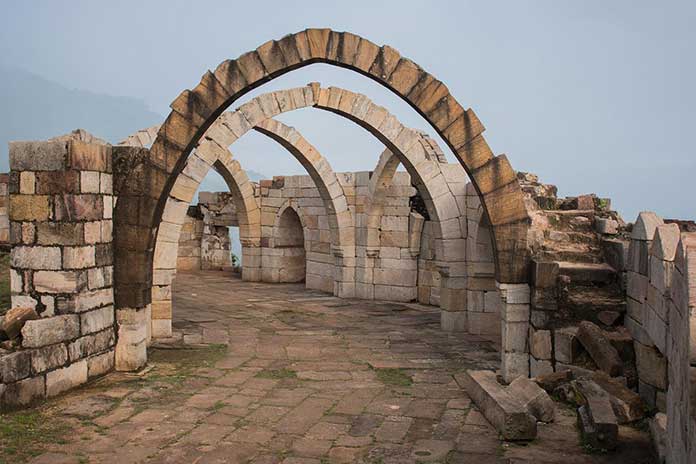
Arches are more strong carriers as they transfer some of the load on them directly to the pillars vertically. In this way, they provide the opportunity to create higher spaces. Nevertheless, the main contribution of an arch is that it provides the opportunity to design wide openings.
If you widen the gap between legs of an arch and enlarge the opening, the height must also increase so that the arch is not too flattened. Because the main principle in the use of the arch is to get rid of the horizontality of the beam and to ensure that the load is shared both horizontally and vertically from the first moment.
Vaults
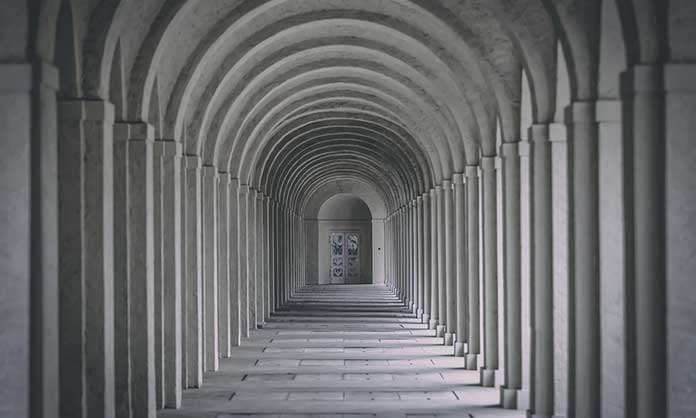
The barrel vault, which is the most primitive form of the vaults that would deeply affect European constructions, is a structural form invented by the Romans. In the simplest meaning, the vaults in Roman architecture are the ceiling system that looks like a half-cylinder formed by arches arranged side by side. In the following periods, vaults have been diversified by undergoing some aesthetic and structural changes in order to increase their carrier.
Types of Roman Buildings
Theaters and bathhouses were widely built in Roman architecture. Apart from that, forums, aqueducts, triumphal arches, basilicas and temples are important building types of Roman architecture.
1. Forum
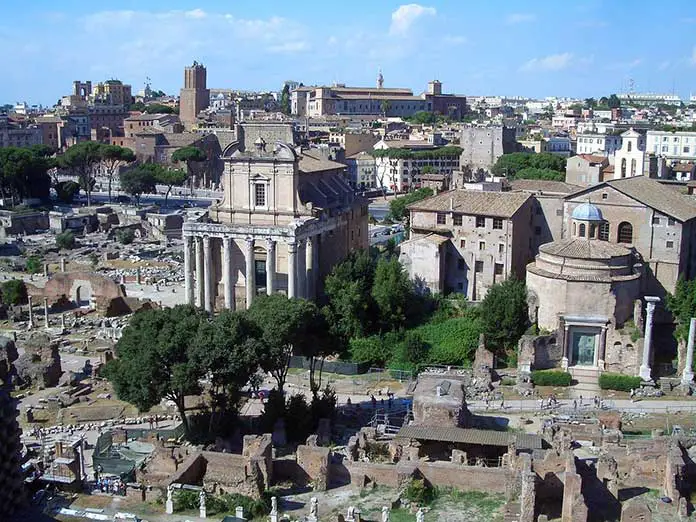
Forums, which are one of the most important public spaces of Roman architecture, are squares containing market places, basilicas and various art galleries. For the Romans, the forum is the socialising place for the citizens.
2. Amphitheater
In Greek architecture, theaters used to designed in the shape of a horseshoe. In order for the seating to rise properly, theaters were usually built on the slope of a mountain. By this way, they designed seating areas by making terracing on a gradually rising slope.
In the ancient architecture of Rome, with the invention of architectural forms such as arches and vaults, theaters could be built in a free space without the need for any sloped hill. Architects built vaults on top of each other to raise turbines. Another difference was that the amphitheaters in Rome were not designed in the shape of a horseshoe, but in the form of a semicircle or a full circle.
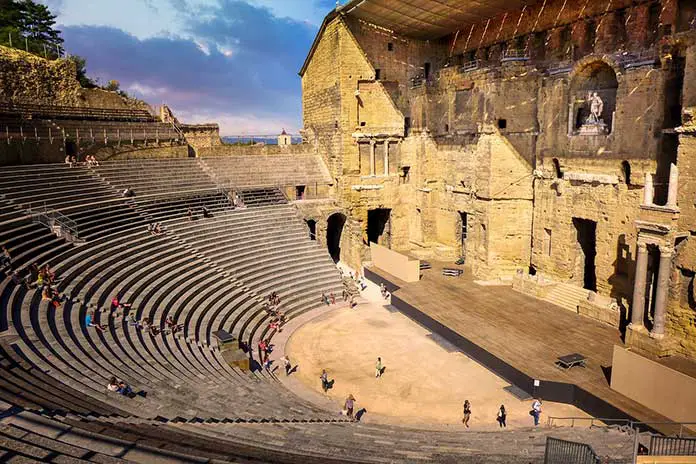
Moreover, there is no space between the stage and the seating areas, as in the Greek theatre. On the contrary, Romans enlarged the stage and combined with the turbine part.
3. Basilica
Basilicas had various public functions. Basilicas used as courtrooms, stock market halls or meeting places were often built in forums, which are centers of active social life. After the adoption of Christianity, basilicas in Rome and Byzantium began to function as religious places. Today, when we say basilica, we think of a plan typology with naves on its sides.
4. Triumphal Arch
The Romans effectively used architecture to spread the glory of the empire in the lands they controlled. The biggest example of this is seen at triumphal arches placed in the cities that the emperors will visit. Especially during the reign of Hadrian, magnificent and monumental triumphal arches were designed. These architectural typologies have no function. It only serves as the city gate for the emperor’s entrance.
5. Streets with Colonnade
Although it is not a design specific to the ancient architecture of Rome, Romans frequently used colonnades in different areas. The Romans, who built miles of colonnades along some important trade routes, viewed this as a symbol of civilization. Thanks to such urban designs, they have reached a very advanced level of consciousness in the field of urbanism.
6. Aqueducts
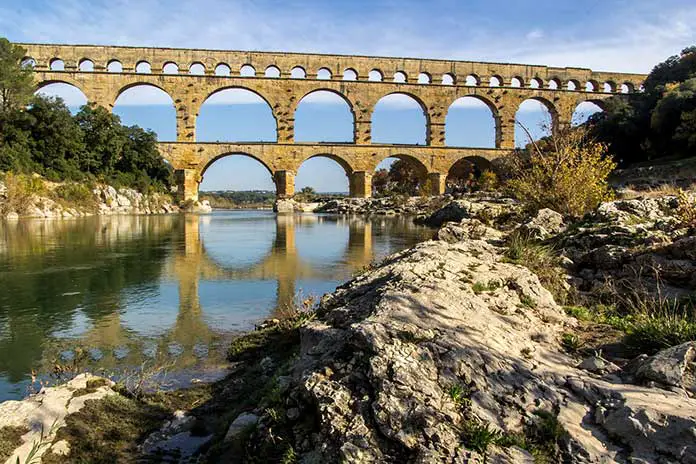
There were 2 important symbols of civilization for the Romans. The first is the road, another is water. Roman people, who eased trade and logistics by blazing roads to different geographies, also designed engineering wonders for the transportation of water. The aqueducts have served to carry the water at high altitudes to the low lying settlements by carrying it through the channel on it.
7. Water Cistern
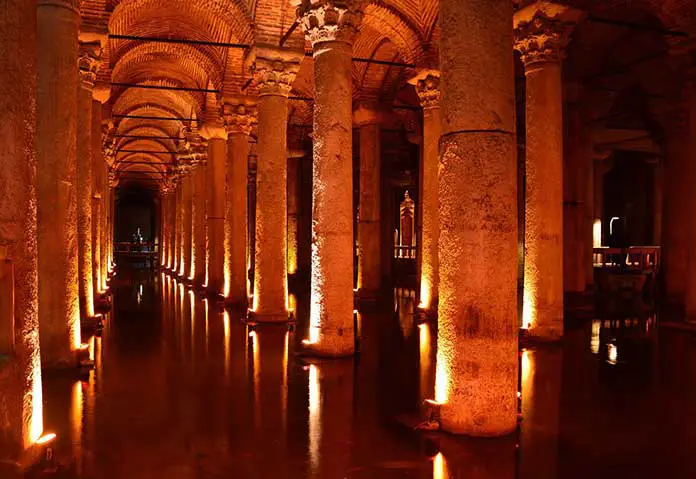
Water transported to residential areas through canals had to be stored. To solve this problem, the Romans built cisterns underground to keep the water cool. These cisterns are supported by many columns in order to carry the soil layer above. Thus, the water cistern has emerged as new architectural typology.
8. Gymnasium
Gymnasiums, on where trainings in the field of sports and philosophical discussions are held, are among the Roman architecture buildings in city centers. In these gymnasiums, colonnaded porticos have been placed in order to symbolize the rational and authoritarian order. Furthermore, they gave great importance to the natural environment design for the development of spiritual mentality.
9. Bathhouse
Baths in Rome are rich places where various activities such as bathing, conversations, doing sports and sleeping can be done. These bathrooms had worked with underfloor heating system.
10. Villa
Although many public building types emerged or developed in Rome, individual buildings designed for the elite class also came to the fore in this period. Roman villas, one of these individual building typology, were magnificent and aesthetic structures. Villas in ancient Rome contained large Roman gardens and atriums.
11. Lighthouse
The Roman Empire, which had coasts on almost all inland seas in North Africa, the Middle East, Europe and Asia, also built a maritime civilization. There were many commercial, individual and military vessels in Rome, which had a serious maritime commerce volume. The lighthouses, which were built to protect all this sea traffic, are architectural building types that reflect the aesthetics of Rome.
Ancient Roman Architecture Examples
Pantheon
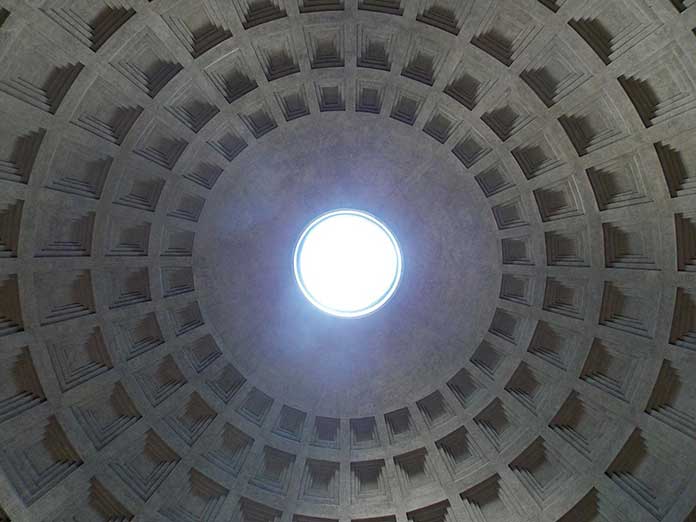
Ancient Greeks and Romans believed in polytheistic religions. Like Greek temples, Roman architecture temples were built to be dedicated to one god. However, the Pantheon built in Rome in 27 BC, was a temple dedicated to all gods. The reflection of such a great religious gift in architecture should have been different. As a matter of fact, the building has been among the most magnificent structures in history for thousands of years with its huge dome.
The diameter of the dome of the Pantheon, which is the pioneer of dome architecture, is approximately 43 meters. In the middle of the dome, there is a 2-meter wide gap called Oculus. Weather events outside can be observed and affect indoors via the Oculus. For instance, when it rains, water can enter through this hole.
Colosseum
Having an oval form, It was among the largest buildings in Ancient architecture of Rome. The building, also known as the Flavianus Amphitheater, is located in Rome, the capital of Italy. This building, which is the most important symbol building of the city, has been used for different functions in history.

Columns on its facade are not carrier elements, but only pilasters that adorn the exterior. There are Doric pilasters on the ground floor, Ionian on the 1st floor, and Corinthian pilasters on the 2nd floor. The main carriers of the building are arches and vaults.
The building, which has a capacity of 50 thousand audience, has also hosted some Gladiator fights. If you are curious about this structure and the atmosphere of that period, you should definitely watch the movie “Gladiator”.
Aqueduct of Valens
The original name of Bozdogan Arches in Istanbul is Valens Aqueduct. Valens, one of the arches built to meet the water needs of Istanbul, was put into service in the 4th century AC. The water carried to the center of Istanbul was stored in hundreds of cisterns. The Valens Aqueduct continued to be used for this purpose during the Eastern Roman and Ottoman periods. It has undergone repairs throughout history. Today, the 921-meter section of it is still standing.
Basilica Cistern
As it is known, it was necessary to store the water transported to the city centers in Rome. The cistern typology was developed for this need. The Basilica Cistern is the most well-known of the cisterns in Istanbul. It is named as the Basilica Cistern, since there was a basilica where the cistern is built, before. The place, which has a 9800 m2 building area, has a water storage capacity of 100,000 tons.
Inside, 336 columns with a height of 9 meters carry the soil and upper sections. According to the official website of the museum, some of these columns were designed in Corinthian style and some in style of Doric architecture. You can visit the website for more information.
Hagia Sophia
It’s one of the most important examples of ancient roman buildings still standing, is located in Istanbul. Hagia Sophia, which had been used for centuries as a place of worship for two different religions, was built 3 times in the same place. The third and final version was completed and put into service in 537. It has been a source of inspiration for Ottoman mosque architecture due to its dome with a diameter of approximately 32 meters and its structural design.

The building has undergone changes by making various additions throughout history and has been used for different purposes. Many materials in the building were gathered and smuggled to the western world. The 1500 years old building maintains its solidity and serves as a mosque today.
Hadrian’s Villa
The Villa of Hadrian, the largest housing project in Rome, contains many buildings and ancient artifacts. This villa complex in Tivoli, built by Emperor Hadrian in the 2nd century AC, was protected as a world heritage site by UNESCO in 1999. The villa, which contains not only residential buildings but also numerous places with various functions, resembles a small palace complex.
Palmyra Ancient City
The city of Palmyra, which was built in the most majestic period of Rome, is among the unique works of ancient architecture of Rome. Since it is located on Syrian territory, Palmyra is an extremely important settlement in terms of showing the borders where Roman architecture spread. Judging by the archaeological excavations, it is possible to pursue the historical traces of Palmyra back to the 19th century BC. However, according to the records of the Romans, we come across the first informations about the city from the 1st century.
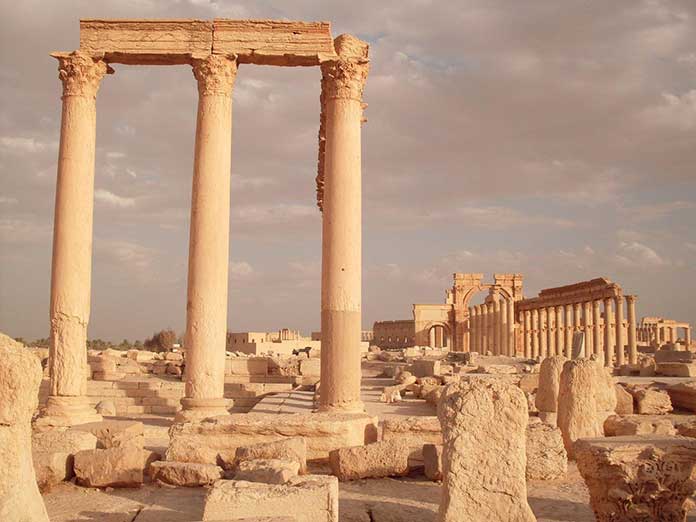
Because the city is located at the intersection of different cultures and trade routes, its architecture has been fed by all these civilizations. It was a very rich settlement with its architectural elements and places such as arcades, agoras, Bel Temple, the senate building and tomb structures. Unfortunately, it took very serious damages in 2014 due to the wars in Syria.
To summarize, architects in the ancient architecture of Rome used new structure types and components. They designed really sturdy and fascinating buildings with these new techniques. And some of these famous Roman architecture buildings are still standing.
Read Also: 25 Most Famous Buildings in Rome



